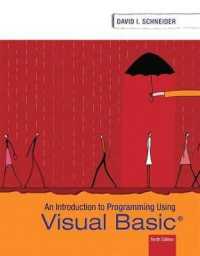- ホーム
- > 洋書
- > 英文書
- > Business / Economics
Full Description
As society becomes increasingly digitized, the boundaries between the physical and virtual worlds blur, giving rise to a dynamic fusion of art, culture, and creativity within the creative industries. In the realm of visual arts, VR and AR have sparked a renaissance of experimentation and expression. The influence of VR and AR extends beyond art, extending its transformative touch to fields like music, literature, and even cultural heritage preservation within the creative industries. The book introduces readers to the roots and evolution of VR and AR, exploring the pioneers, breakthroughs, and influential developments that have paved the way for their integration into everyday life.
The book includes case studies and real-world examples showcasing how these cutting-edge technologies have revolutionized cultural experiences within the creative industries. From virtual museums that transport visitors to distant historical eras, to augmented reality installations that merge digital art with physical spaces, the book uncovers a myriad of innovative applications within the fields of design, media, fashion, gaming, and more.
The profound societal implications of these technologies within the creative industries are examined in detail and the research addresses the challenges and ethical considerations surrounding VR and AR within the creative industries. The book culminates with a compelling vision of the future, exploring how these technologies are set to reshape culture and creativity within the creative industries in the years to come.
Contents
Chapter 1. Beyond the Runway: A Comprehensive Review of XR Opportunities, Applications and Challenges in the Fashion Industry; Neetu Singh
Chapter 2. Designing Concept Art for VR Presentations of Cultural Heritage: Visual Communication, Multimedia and Education; Emir Durmišević
Chapter 3. Transforming Dubrovnik's Legacy: Extended Reality and the Tourist Experience; Milivoj Marković, Kevin Walker, and Milena Kužnin
Chapter 4. Immersive Phygital Technologies to Interpret a Counterfactual World War II Invasion; Martin G. Debattista
Chapter 5. Bringing Castles and Museums to Life: A Case Study on the Use of XR Technology in Northern Croatia and Slovenia; Andrijana Kos Kavran, Martina Ferenčić, and Jasmina Dlačić
Chapter 6. Exploring the Impact of Augmented Reality Marketing on Destination Visit Intentions: A Stimulus-Organism-Response Framework Analysis; Kishokanth Jeganathan and Andrzej Szymkowiak
Chapter 7. Application of VR and AR in Museums: The Case of Three Croatian Museums; Tanja Komarac and Đurđana Ozretić Došen
Chapter 8. The Role of Virtual Reality in Experiencing Intangible Cultural Heritage: Case Study Sarajevo VRX Immersive Museum; Amra Banda, Belma Durmišević, Muniba Osmanović, and Jovana Musić
Chapter 9. The Use of Extended Reality Technologies in the Presentation of the Roman Emperors Route and Danube Wine Route: A Case Study Analysis; Goran Petković, Michael Werner, Brooke Hansen, and Danko Ćosić
Chapter 10. Immersive Encounters with Tragedy: The Role of Virtual Reality in Enhancing Dark Tourism Experiences, Education and Transformative Engagement; Dušan Mladenović and Sanja Dolenec
Chapter 11. Using XR Technologies to Present Underwater Cultural Heritage: The Case Study of the Wrecks4All Project; Darko Kovačević and Mijana Matošević Radić








